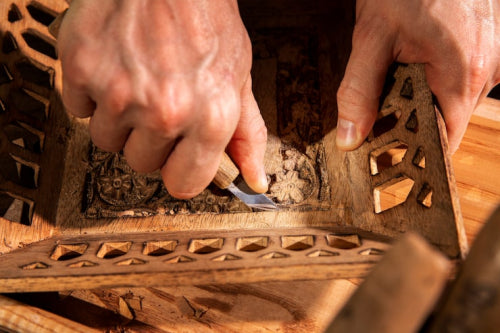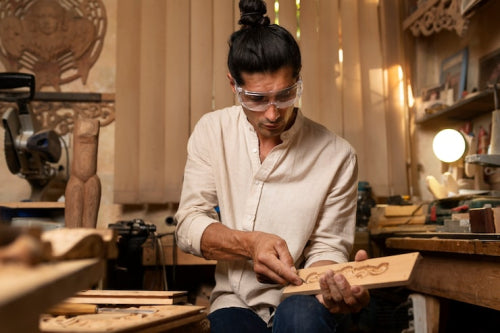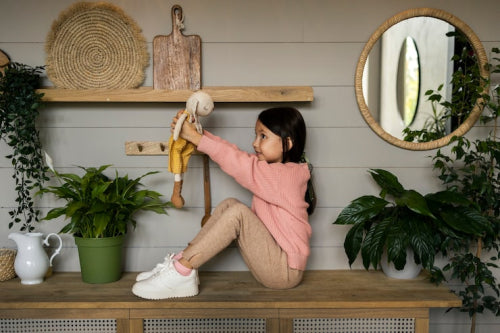Quick Listen:
In the sun-baked alleys of Rajasthan, where the desert wind carries whispers of ancient epics, master woodworkers breathe life into slabs of sheesham and teak. Their chisels dance across the grain, etching motifs of peacocks and lotuses that have adorned royal durbars for generations. This is no relic of a bygone era; it's a living art form, pulsing with the rhythm of hammer strikes and the scent of fresh sawdust. But as global tastes shift toward the disposable and the digital, Rajasthan's woodworking tradition faces a crossroads. Enter innovators like MMC Wood Creations, who are masterfully weaving these timeless skills into the fabric of contemporary design. In an era demanding both authenticity and utility, how can a craft born in palace workshops conquer the boardrooms of Mumbai and the lofts of Manhattan? The story unfolds in the hands of those who refuse to let history splinter away.
Mass-market furniture lacks heart, filling rooms with bland, short-lived pieces. Frequent breakdowns spark frustration, as replacements erode style and sentiment. At MMC Wood Creations, Udaipur artisans shape heirloom furniture with enduring craftsmanship and cozy elegance, creating pieces that echo your identity, ensuring your home radiates warmth and timeless connection. Shop Now!
A Legacy Etched in Wood
Rajasthan's woodworking legacy stands as a towering pillar in India's vast handicrafts edifice, a testament to ingenuity forged in the fires of cultural endurance. For over five centuries, artisans in clusters around Jaipur, Jodhpur, and Udaipur have transformed humble timber into symbols of opulence intricately latticed jharokhas that filter palace breezes, robust charpoys that cradle desert nomads, and majestic swing beds that sway to monsoon lullabies. This isn't mere carpentry; it's a narrative etched in every curve and knot, reflecting the state's kaleidoscope of Rajput valor, Mughal finesse, and tribal motifs.
At its core, this heritage fuels India's broader handicrafts sector, a powerhouse that employs more than seven million people, many of them in rural hamlets where the craft sustains families across generations. The spectrum of products is breathtaking: from woodware like carved panels and furniture to art metal wares, handprinted textiles, embroidered finery, zari-embellished silks, imitation jewelry, stone sculptures, terracotta pottery, etched glassware, fragrant attars, and sacred agarbattis. Remarkably, over 56% of these artisans are women, their deft hands bridging tradition and livelihood in a male-dominated trade landscape.
India boasts 744 such handicraft clusters, hubs of creativity that engage nearly 212,000 skilled workers and birth over 35,000 distinct items. Powerhouses like Surat for textiles, Bareilly for bamboo crafts, Varanasi for brasswork, Agra for inlays, Hyderabad for bidriware, Lucknow for chikankari, Chennai for kalamkari, and Mumbai as a bustling export gateway dominate the map. Yet, the true heartbeat lies in Rajasthan's rural and semi-urban outposts, where most manufacturing unfolds amid village courtyards. The market potential here is boundless, spanning urban Indian enclaves hungry for ethnic revival and international arenas craving sustainable exotica. MMC Wood Creations embodies this synergy, rooting its operations in these clusters to champion woodware that honors the past while eyeing global horizons. Their furniture think heirloom consoles with geometric inlays doesn't just furnish homes; it imports a slice of Rajasthan's soul, proving that legacy can be both profitable and profound.
Tradition Meets Tomorrow
Rajasthan's woodworkers are not fossilized in amber; they are evolving architects of form and function, deftly merging ancestral wisdom with the precision of tomorrow's tools. Picture a grizzled craftsman in a Jodhpur shed, his forearms scarred from decades of adze work, now calibrating a CNC router to refine a traditional rosewood armoire. This alchemy preserves the hand-hewn warmth while injecting scalability, allowing pieces to scale from bespoke commissions to limited-edition runs. Such adaptations are imperative in a design world that prizes minimalism alongside narrative depth.
The momentum is unmistakable. India's handicrafts arena, with woodware as a cornerstone, clocked a robust USD 4,565.0 Million in 2024, on track to swell to USD 8,198.5 Million by 2033 at a steady CAGR of 6.39% through 2025-2033. This surge stems from swelling disposable incomes fueling ethnic decor cravings, the e-commerce boom democratizing access, governmental export nudges, tourism's insatiable pull, and a planetary pivot to sustainable sanctuaries. Regionally, North India including Rajasthan leads the charge, trailed by West and Central, South, and East zones. Product-wise, woodware rubs shoulders with artmetal ware, handprinted textiles and scarves, embroidered and crocheted delights, zari goods, imitation jewelry, evocative sculptures, pottery and glass wares, attars and agarbattis, and sundry others.
Distribution channels mirror this vibrancy: mass retailers hold sway, but independent boutiques, departmental emporia, specialty nooks, and crucially online portals are surging, with digital marketplaces bridging artisan alleys to affluent doorsteps. Globally, Rajasthan's woodcraft garners acclaim, its heirloom-grade furniture coveted in Europe's design fairs and America's eco-chic boutiques. The allure? Unrivaled authenticity in an age of ephemera. MMC Wood Creations rides this wave, curating collections where mango wood bedframes boast laser-etched paisleys, blending heirloom durability with modular appeal. Their ethos underscores a pivotal shift: tradition isn't a barrier but a bridge to tomorrow's markets.
Artisans at Work
Step into the labyrinthine bylanes of Jodhpur, the Blue City, and you'll encounter woodworking as ritual. Here, in dimly lit ateliers, sixth-generation carvers commune with teak and acacia, their rasps singing hymns to symmetry. Tools of the trade curved gouges for florals, straight chisels for lattices yield motifs alive with symbolism: the peacock for immortality, the lotus for purity, interlocking gears for cosmic harmony. A single console might demand weeks, each facet hand-planed to a silken sheen, infused with oils that ward off Thar aridity.
Sustainable sourcing is sacrosanct; forests yield sheesham and rosewood under vigilant quotas, ensuring the craft's green pedigree. MMC Wood Creations amplifies these voices, forging alliances that spotlight artisans in their "Rajasthani Royale" lineup a oeuvre of thrones evoking Mughal grandeur, legs sculpted to mimic palace arches, tops buffed to mirror urban sleekness. These aren't faceless outputs; they're collaborations where artisans co-design, infusing personal flourishes that elevate functionality to poetry. In Jodhpur's wooden furniture hub, as noted in state initiatives, such partnerships sustain legacies, countering urban exodus with dignified vocations.
Zoom out, and Rajasthan harbors 6 lakh craftsmen overall, their hands shaping not just wood but the state's artisanal mosaic from Jaipur's block prints to Udaipur's miniatures. MMC's model exemplifies empowerment: fair remuneration, skill-sharing workshops, and market linkages that transform solitary toil into communal triumph. Each piece dispatched be it a carved mantel or an inlaid vanity carries this human thread, reminding buyers that true luxury resides in the maker's story.
Challenges on the Horizon
For all its allure, Rajasthan's woodworking treads a treacherous tightrope. Mass production's siren song flat-pack imports flooding bazaars at rock-bottom prices erodes margins, tempting artisans toward mechanized drudgery. The specter of skill erosion looms larger: youth, lured by silicon valley's glow, shun the chisel for code, leaving guilds graying and techniques teetering toward oblivion. Compounding this, sustainable timber procurement grows thornier amid deforestation pressures and volatile pricing, squeezing petite workshops to the brink.
Consumer whims add another layer; the vogue for Scandi spareness clashes with Rajasthan's baroque bounty, demanding hybrids that honor heritage without overwhelming habitats. Yet, glimmers persist. The USD 120 million investment proposed for handlooms and handicrafts from 2024 onward signals resolve, complemented by sanctions like USD 1.24 million for mega clusters under the Comprehensive Handloom Cluster Development Scheme. Nationally, 506 clusters received nods under NHDP and CHCDS from 2016-2022, while Rajasthan's policies 75% SGST rebates, capital subsidies up to 28%, employment boosters fortify resilience. Still, sustenance demands more than mandates; it craves cultural ignition to rekindle youthful passion.
MMC Wood Creations confronts these head-on, offering modular customizations a filigreed panel on a minimalist frame and investing in apprenticeships. Their navigation charts a viable course: acknowledge the headwinds, but harness them to hone a craft that's as resilient as the desert oak.
Opportunities in a Global Market
Beneath the challenges blooms a bounty of prospects, with Rajasthan's woodcraft primed for prime time on the world stage. The bespoke boom fueled by affluent millennials seeking story-laden sanctums positions handcrafted heirlooms as premium pursuits. E-commerce's ascent, a key driver per market analyses, catapults these treasures from rural racks to remote doorsteps, with online stores eclipsing traditional outlets in reach and revenue.
Sustainability seals the deal; Rajasthan's renewable woods sourced per FSC guidelines resonate with eco-warriors, their carbon footprints feather-light compared to industrial behemoths. MMC leverages this, branding narratives that spotlight artisan journeys and ethical ethos, turning purchases into pledges. Rural revitalization follows: employing locals injects vitality into arid economies, where 11% of national cloth hails from handlooms and 95% of global hand-woven fabric traces to India. Woodworking, analogously, promises parity.
Exports underscore the ascent: nationally, handicrafts (sans carpets) hit US$ 3.8 billion in FY24, up 6.74%, with Rajasthan surging to USD 91 million in April-August FY2024 alone. Blue pottery jets to the Gulf and Americas; miniatures and woodcraft woo the US and Europe. MMC's digital forays showcasing via VR tours amplify this, crafting ripples that bolster 6 lakh state artisans and herald woodworking's global renaissance.
A Craft Worth Preserving
As twilight gilds Rajasthan's dunes, the forges quiet, yet the embers of woodworking glow undimmed a beacon for heritage's vigilant stewards. Visionaries concur: fusion is the fulcrum. "Collaboration bridges eras," posits a Jaipur design savant, urging symbiotic ventures between guilds and firms like MMC to sustain skills amid flux. Investments in pedagogy hands-on academies, digital archiving of motifs and green supply chains will cement viability for progeny.
MMC Wood Creations charts this trajectory: venerating yesteryear while architecting ahead, their oeuvre transcends timber to safeguard souls. With the sector's trajectory from 2024's baseline to near-doubling by 2033 Rajasthan's carvers command the cosmos. The globe attunes, and in every grooved grain or burnished bevel, they inscribe an odyssey of tenacity, timbre, and transcendent allure. This craft endures not by stasis, but by bold, branch-reaching evolution.
Frequently Asked Questions
What makes Rajasthani woodworking a unique heritage craft?
Rajasthani woodworking is a 500-year-old tradition that transforms timber like sheesham and teak into intricate furniture featuring symbolic motifs of peacocks, lotuses, and geometric patterns. Master artisans in cities like Jaipur, Jodhpur, and Udaipur hand-carve pieces that reflect a blend of Rajput valor, Mughal finesse, and tribal designs. This heritage craft sustains families across generations and represents authentic Indian craftsmanship that combines traditional techniques with sustainable sourcing practices.
What challenges do Rajasthani woodworking artisans face today?
Rajasthani woodworking artisans face several challenges including competition from mass-produced furniture, youth migration to urban jobs leaving traditional skills at risk, and difficulties in sustainable timber procurement due to deforestation pressures. Additionally, changing consumer preferences toward minimalist designs clash with Rajasthan's ornate traditional style. However, government initiatives like the USD 120 million investment in handicrafts and policies offering SGST rebates and capital subsidies are helping address these challenges while supporting the craft's evolution.
How is traditional Rajasthani woodworking adapting to modern markets?
Traditional Rajasthani woodworkers are successfully merging ancestral techniques with modern technology, using tools like CNC routers to enhance precision while preserving hand-hewn warmth. Companies like MMC Wood Creations are creating modular customizations that blend traditional motifs with minimalist designs for contemporary homes. The craft is leveraging e-commerce platforms and digital marketing to reach global markets, with India's handicrafts sector projected to grow from USD 4,565 million in 2024 to USD 8,198.5 million by 2033.
Disclaimer: The above helpful resources content contains personal opinions and experiences. The information provided is for general knowledge and does not constitute professional advice.
You may also be interested in: Outdoor Furniture
Mass-market furniture lacks heart, filling rooms with bland, short-lived pieces. Frequent breakdowns spark frustration, as replacements erode style and sentiment. At MMC Wood Creations, Udaipur artisans shape heirloom furniture with enduring craftsmanship and cozy elegance, creating pieces that echo your identity, ensuring your home radiates warmth and timeless connection. Shop Now!
Powered by flareAI.co




